ENG 720: Machine Learning Techniques for Radiative Transfer Inversion
VerifiedAdded on 2021/04/24
|12
|3941
|137
Report
AI Summary
This report explores the application of machine learning techniques for inverting the radiative transfer equation, focusing on optical properties and their impact on light signals interacting with various materials. It reviews the use of neural networks in spectroscopy, particularly for extracting optical properties from scattering matrices and in nano-semiconductor processing. The report also discusses the use of neural networks in industrial processes for modeling and compensating for non-linearities, as well as in medical applications like diffuse reflectance spectroscopy (DRS) for analyzing deep tissues. It highlights the importance of well-characterized training data, the challenges of obtaining experimental data in nano-processing, and the advantages of using Monte Carlo simulations with neural networks for accurate computation in DRS. The document emphasizes the potential of machine learning to improve the accuracy and efficiency of optical property determination in diverse fields.
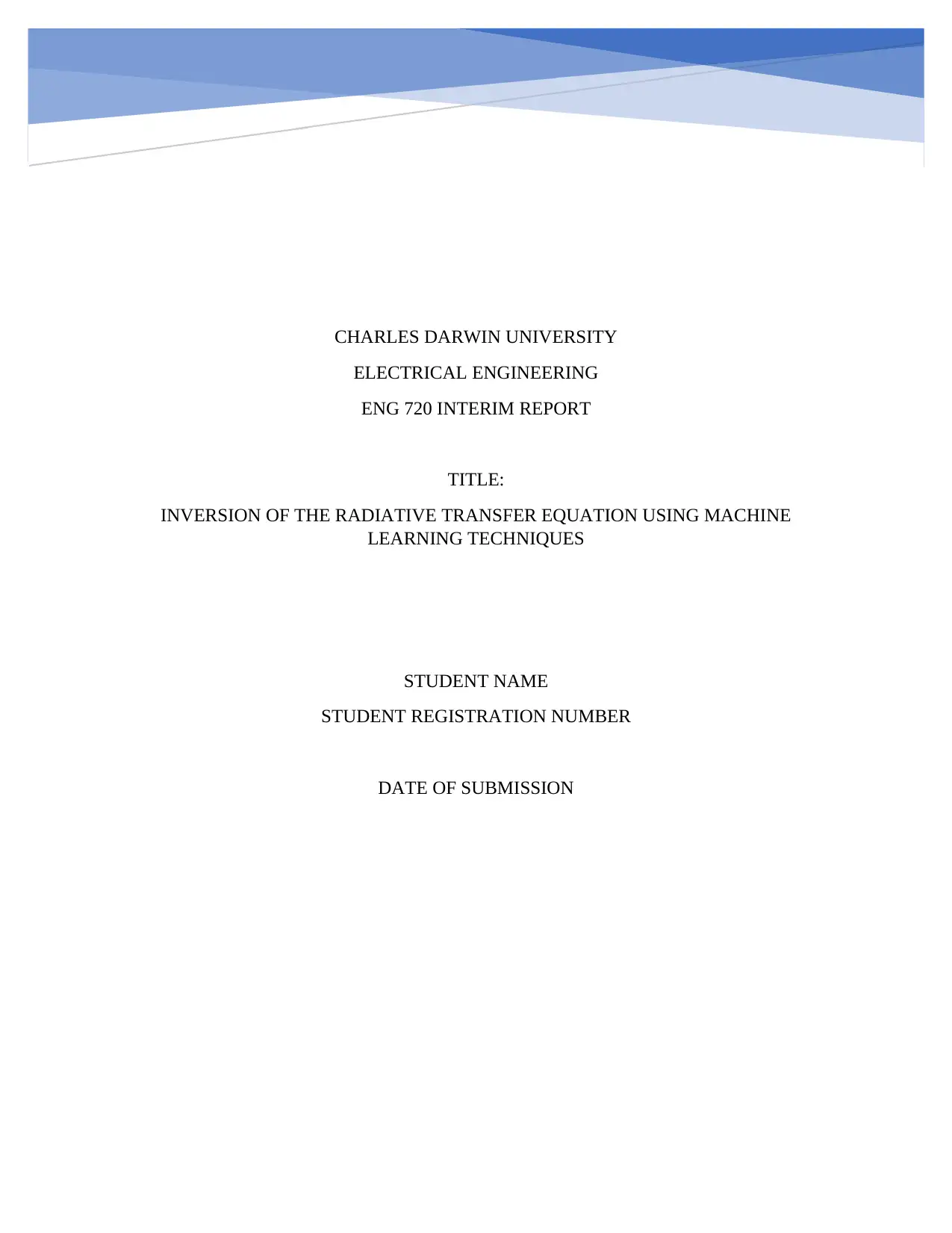
CHARLES DARWIN UNIVERSITY
ELECTRICAL ENGINEERING
ENG 720 INTERIM REPORT
TITLE:
INVERSION OF THE RADIATIVE TRANSFER EQUATION USING MACHINE
LEARNING TECHNIQUES
STUDENT NAME
STUDENT REGISTRATION NUMBER
DATE OF SUBMISSION
ELECTRICAL ENGINEERING
ENG 720 INTERIM REPORT
TITLE:
INVERSION OF THE RADIATIVE TRANSFER EQUATION USING MACHINE
LEARNING TECHNIQUES
STUDENT NAME
STUDENT REGISTRATION NUMBER
DATE OF SUBMISSION
Paraphrase This Document
Need a fresh take? Get an instant paraphrase of this document with our AI Paraphraser
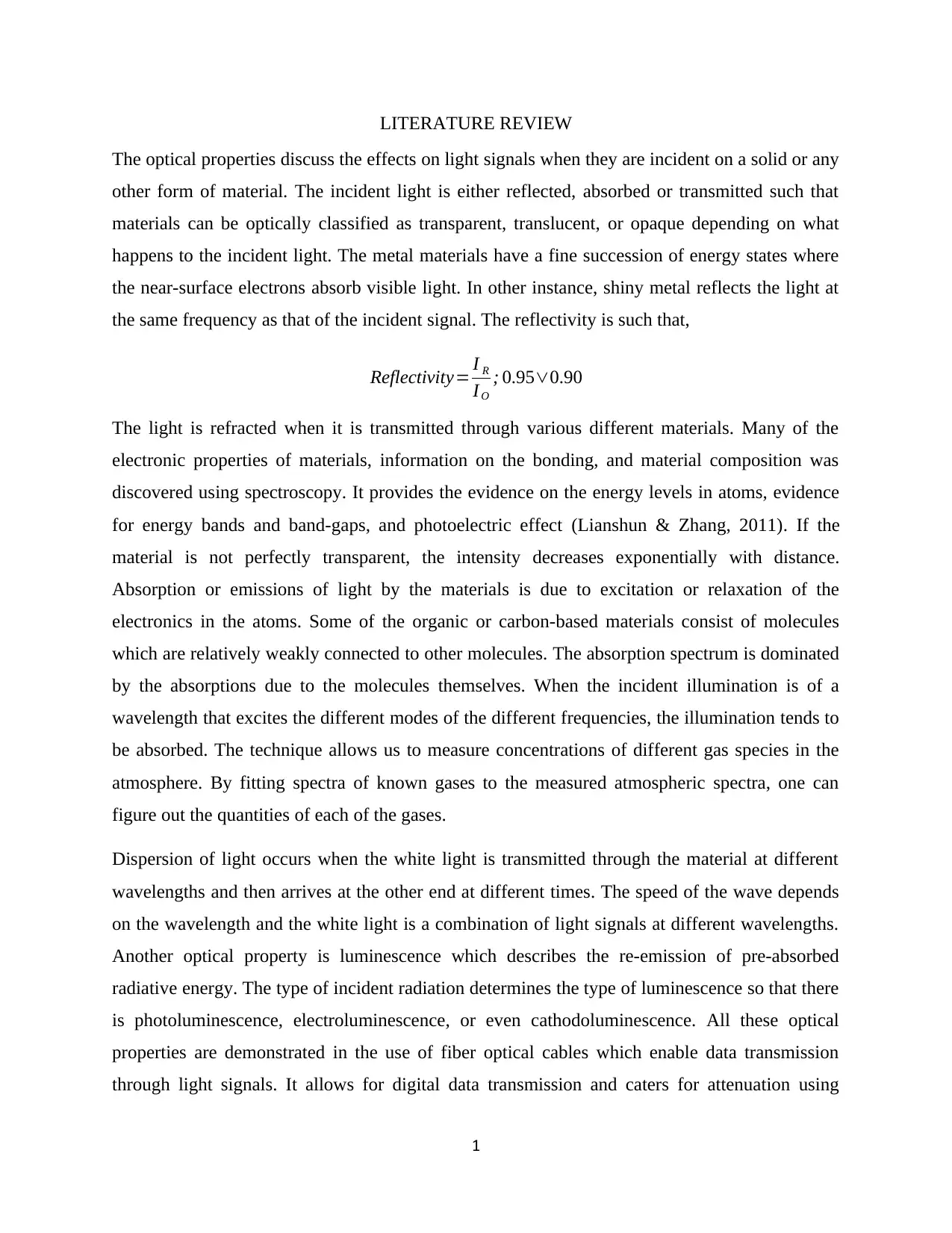
LITERATURE REVIEW
The optical properties discuss the effects on light signals when they are incident on a solid or any
other form of material. The incident light is either reflected, absorbed or transmitted such that
materials can be optically classified as transparent, translucent, or opaque depending on what
happens to the incident light. The metal materials have a fine succession of energy states where
the near-surface electrons absorb visible light. In other instance, shiny metal reflects the light at
the same frequency as that of the incident signal. The reflectivity is such that,
Reflectivity= I R
I O
; 0.95∨0.90
The light is refracted when it is transmitted through various different materials. Many of the
electronic properties of materials, information on the bonding, and material composition was
discovered using spectroscopy. It provides the evidence on the energy levels in atoms, evidence
for energy bands and band-gaps, and photoelectric effect (Lianshun & Zhang, 2011). If the
material is not perfectly transparent, the intensity decreases exponentially with distance.
Absorption or emissions of light by the materials is due to excitation or relaxation of the
electronics in the atoms. Some of the organic or carbon-based materials consist of molecules
which are relatively weakly connected to other molecules. The absorption spectrum is dominated
by the absorptions due to the molecules themselves. When the incident illumination is of a
wavelength that excites the different modes of the different frequencies, the illumination tends to
be absorbed. The technique allows us to measure concentrations of different gas species in the
atmosphere. By fitting spectra of known gases to the measured atmospheric spectra, one can
figure out the quantities of each of the gases.
Dispersion of light occurs when the white light is transmitted through the material at different
wavelengths and then arrives at the other end at different times. The speed of the wave depends
on the wavelength and the white light is a combination of light signals at different wavelengths.
Another optical property is luminescence which describes the re-emission of pre-absorbed
radiative energy. The type of incident radiation determines the type of luminescence so that there
is photoluminescence, electroluminescence, or even cathodoluminescence. All these optical
properties are demonstrated in the use of fiber optical cables which enable data transmission
through light signals. It allows for digital data transmission and caters for attenuation using
1
The optical properties discuss the effects on light signals when they are incident on a solid or any
other form of material. The incident light is either reflected, absorbed or transmitted such that
materials can be optically classified as transparent, translucent, or opaque depending on what
happens to the incident light. The metal materials have a fine succession of energy states where
the near-surface electrons absorb visible light. In other instance, shiny metal reflects the light at
the same frequency as that of the incident signal. The reflectivity is such that,
Reflectivity= I R
I O
; 0.95∨0.90
The light is refracted when it is transmitted through various different materials. Many of the
electronic properties of materials, information on the bonding, and material composition was
discovered using spectroscopy. It provides the evidence on the energy levels in atoms, evidence
for energy bands and band-gaps, and photoelectric effect (Lianshun & Zhang, 2011). If the
material is not perfectly transparent, the intensity decreases exponentially with distance.
Absorption or emissions of light by the materials is due to excitation or relaxation of the
electronics in the atoms. Some of the organic or carbon-based materials consist of molecules
which are relatively weakly connected to other molecules. The absorption spectrum is dominated
by the absorptions due to the molecules themselves. When the incident illumination is of a
wavelength that excites the different modes of the different frequencies, the illumination tends to
be absorbed. The technique allows us to measure concentrations of different gas species in the
atmosphere. By fitting spectra of known gases to the measured atmospheric spectra, one can
figure out the quantities of each of the gases.
Dispersion of light occurs when the white light is transmitted through the material at different
wavelengths and then arrives at the other end at different times. The speed of the wave depends
on the wavelength and the white light is a combination of light signals at different wavelengths.
Another optical property is luminescence which describes the re-emission of pre-absorbed
radiative energy. The type of incident radiation determines the type of luminescence so that there
is photoluminescence, electroluminescence, or even cathodoluminescence. All these optical
properties are demonstrated in the use of fiber optical cables which enable data transmission
through light signals. It allows for digital data transmission and caters for attenuation using
1
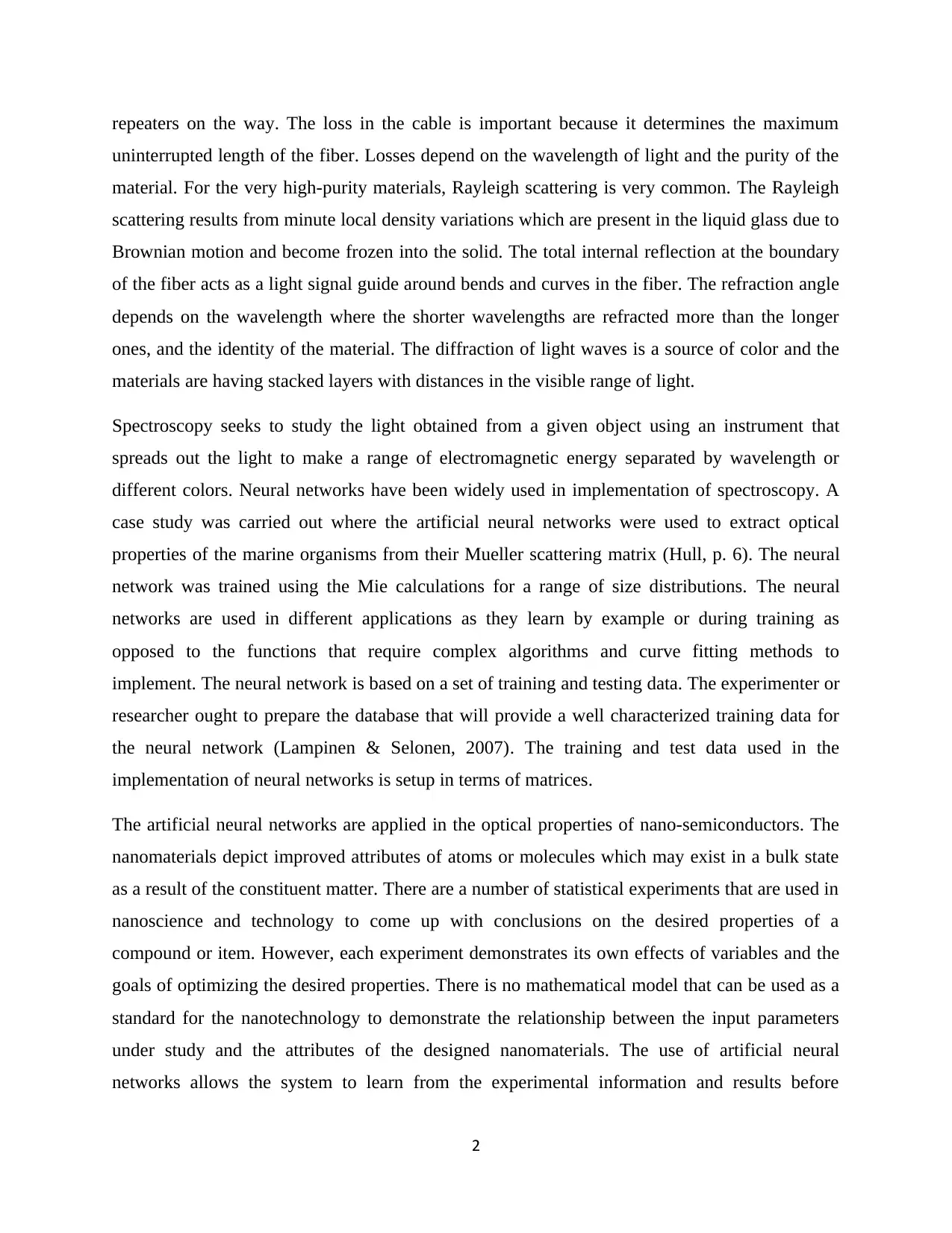
repeaters on the way. The loss in the cable is important because it determines the maximum
uninterrupted length of the fiber. Losses depend on the wavelength of light and the purity of the
material. For the very high-purity materials, Rayleigh scattering is very common. The Rayleigh
scattering results from minute local density variations which are present in the liquid glass due to
Brownian motion and become frozen into the solid. The total internal reflection at the boundary
of the fiber acts as a light signal guide around bends and curves in the fiber. The refraction angle
depends on the wavelength where the shorter wavelengths are refracted more than the longer
ones, and the identity of the material. The diffraction of light waves is a source of color and the
materials are having stacked layers with distances in the visible range of light.
Spectroscopy seeks to study the light obtained from a given object using an instrument that
spreads out the light to make a range of electromagnetic energy separated by wavelength or
different colors. Neural networks have been widely used in implementation of spectroscopy. A
case study was carried out where the artificial neural networks were used to extract optical
properties of the marine organisms from their Mueller scattering matrix (Hull, p. 6). The neural
network was trained using the Mie calculations for a range of size distributions. The neural
networks are used in different applications as they learn by example or during training as
opposed to the functions that require complex algorithms and curve fitting methods to
implement. The neural network is based on a set of training and testing data. The experimenter or
researcher ought to prepare the database that will provide a well characterized training data for
the neural network (Lampinen & Selonen, 2007). The training and test data used in the
implementation of neural networks is setup in terms of matrices.
The artificial neural networks are applied in the optical properties of nano-semiconductors. The
nanomaterials depict improved attributes of atoms or molecules which may exist in a bulk state
as a result of the constituent matter. There are a number of statistical experiments that are used in
nanoscience and technology to come up with conclusions on the desired properties of a
compound or item. However, each experiment demonstrates its own effects of variables and the
goals of optimizing the desired properties. There is no mathematical model that can be used as a
standard for the nanotechnology to demonstrate the relationship between the input parameters
under study and the attributes of the designed nanomaterials. The use of artificial neural
networks allows the system to learn from the experimental information and results before
2
uninterrupted length of the fiber. Losses depend on the wavelength of light and the purity of the
material. For the very high-purity materials, Rayleigh scattering is very common. The Rayleigh
scattering results from minute local density variations which are present in the liquid glass due to
Brownian motion and become frozen into the solid. The total internal reflection at the boundary
of the fiber acts as a light signal guide around bends and curves in the fiber. The refraction angle
depends on the wavelength where the shorter wavelengths are refracted more than the longer
ones, and the identity of the material. The diffraction of light waves is a source of color and the
materials are having stacked layers with distances in the visible range of light.
Spectroscopy seeks to study the light obtained from a given object using an instrument that
spreads out the light to make a range of electromagnetic energy separated by wavelength or
different colors. Neural networks have been widely used in implementation of spectroscopy. A
case study was carried out where the artificial neural networks were used to extract optical
properties of the marine organisms from their Mueller scattering matrix (Hull, p. 6). The neural
network was trained using the Mie calculations for a range of size distributions. The neural
networks are used in different applications as they learn by example or during training as
opposed to the functions that require complex algorithms and curve fitting methods to
implement. The neural network is based on a set of training and testing data. The experimenter or
researcher ought to prepare the database that will provide a well characterized training data for
the neural network (Lampinen & Selonen, 2007). The training and test data used in the
implementation of neural networks is setup in terms of matrices.
The artificial neural networks are applied in the optical properties of nano-semiconductors. The
nanomaterials depict improved attributes of atoms or molecules which may exist in a bulk state
as a result of the constituent matter. There are a number of statistical experiments that are used in
nanoscience and technology to come up with conclusions on the desired properties of a
compound or item. However, each experiment demonstrates its own effects of variables and the
goals of optimizing the desired properties. There is no mathematical model that can be used as a
standard for the nanotechnology to demonstrate the relationship between the input parameters
under study and the attributes of the designed nanomaterials. The use of artificial neural
networks allows the system to learn from the experimental information and results before
2
⊘ This is a preview!⊘
Do you want full access?
Subscribe today to unlock all pages.

Trusted by 1+ million students worldwide
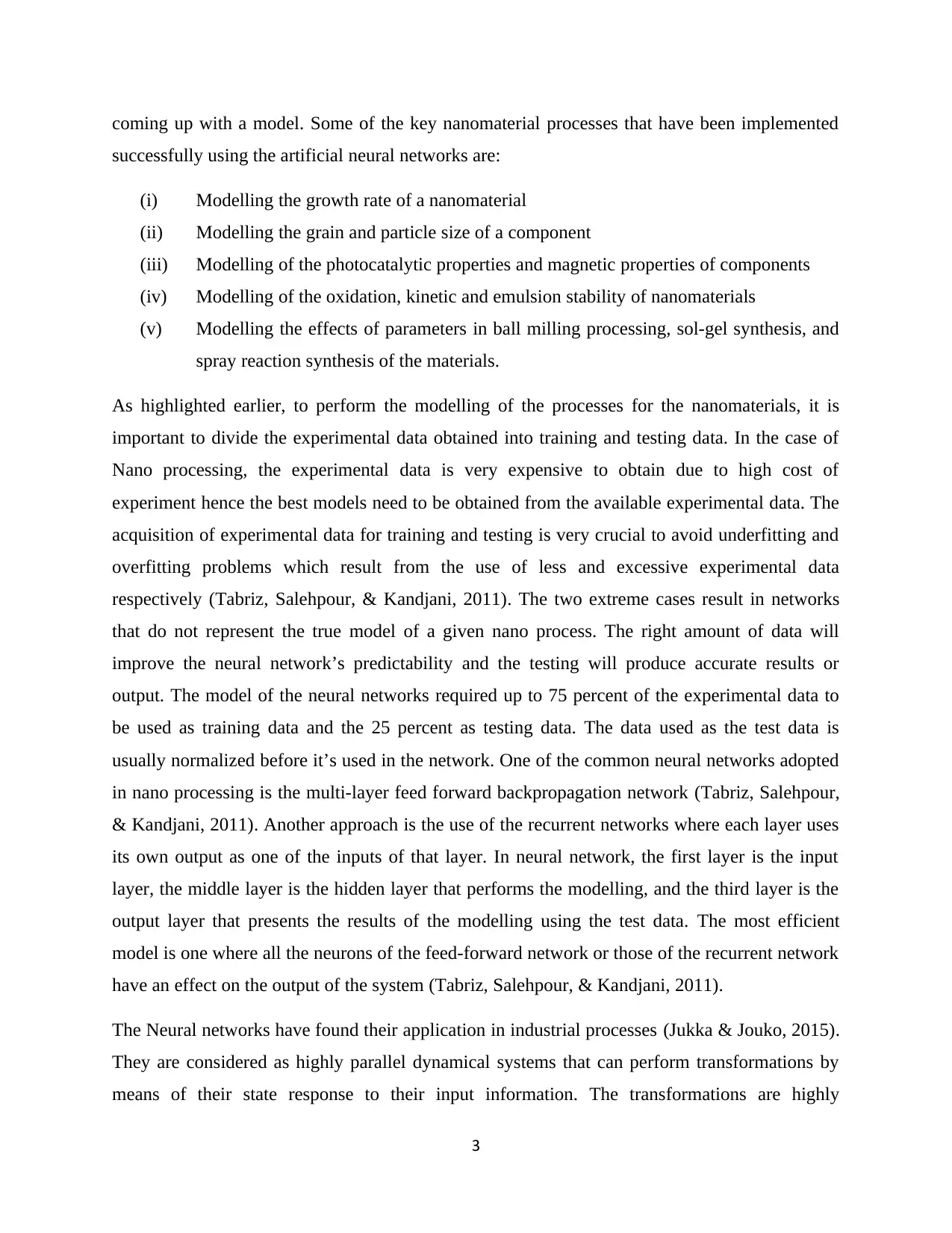
coming up with a model. Some of the key nanomaterial processes that have been implemented
successfully using the artificial neural networks are:
(i) Modelling the growth rate of a nanomaterial
(ii) Modelling the grain and particle size of a component
(iii) Modelling of the photocatalytic properties and magnetic properties of components
(iv) Modelling of the oxidation, kinetic and emulsion stability of nanomaterials
(v) Modelling the effects of parameters in ball milling processing, sol-gel synthesis, and
spray reaction synthesis of the materials.
As highlighted earlier, to perform the modelling of the processes for the nanomaterials, it is
important to divide the experimental data obtained into training and testing data. In the case of
Nano processing, the experimental data is very expensive to obtain due to high cost of
experiment hence the best models need to be obtained from the available experimental data. The
acquisition of experimental data for training and testing is very crucial to avoid underfitting and
overfitting problems which result from the use of less and excessive experimental data
respectively (Tabriz, Salehpour, & Kandjani, 2011). The two extreme cases result in networks
that do not represent the true model of a given nano process. The right amount of data will
improve the neural network’s predictability and the testing will produce accurate results or
output. The model of the neural networks required up to 75 percent of the experimental data to
be used as training data and the 25 percent as testing data. The data used as the test data is
usually normalized before it’s used in the network. One of the common neural networks adopted
in nano processing is the multi-layer feed forward backpropagation network (Tabriz, Salehpour,
& Kandjani, 2011). Another approach is the use of the recurrent networks where each layer uses
its own output as one of the inputs of that layer. In neural network, the first layer is the input
layer, the middle layer is the hidden layer that performs the modelling, and the third layer is the
output layer that presents the results of the modelling using the test data. The most efficient
model is one where all the neurons of the feed-forward network or those of the recurrent network
have an effect on the output of the system (Tabriz, Salehpour, & Kandjani, 2011).
The Neural networks have found their application in industrial processes (Jukka & Jouko, 2015).
They are considered as highly parallel dynamical systems that can perform transformations by
means of their state response to their input information. The transformations are highly
3
successfully using the artificial neural networks are:
(i) Modelling the growth rate of a nanomaterial
(ii) Modelling the grain and particle size of a component
(iii) Modelling of the photocatalytic properties and magnetic properties of components
(iv) Modelling of the oxidation, kinetic and emulsion stability of nanomaterials
(v) Modelling the effects of parameters in ball milling processing, sol-gel synthesis, and
spray reaction synthesis of the materials.
As highlighted earlier, to perform the modelling of the processes for the nanomaterials, it is
important to divide the experimental data obtained into training and testing data. In the case of
Nano processing, the experimental data is very expensive to obtain due to high cost of
experiment hence the best models need to be obtained from the available experimental data. The
acquisition of experimental data for training and testing is very crucial to avoid underfitting and
overfitting problems which result from the use of less and excessive experimental data
respectively (Tabriz, Salehpour, & Kandjani, 2011). The two extreme cases result in networks
that do not represent the true model of a given nano process. The right amount of data will
improve the neural network’s predictability and the testing will produce accurate results or
output. The model of the neural networks required up to 75 percent of the experimental data to
be used as training data and the 25 percent as testing data. The data used as the test data is
usually normalized before it’s used in the network. One of the common neural networks adopted
in nano processing is the multi-layer feed forward backpropagation network (Tabriz, Salehpour,
& Kandjani, 2011). Another approach is the use of the recurrent networks where each layer uses
its own output as one of the inputs of that layer. In neural network, the first layer is the input
layer, the middle layer is the hidden layer that performs the modelling, and the third layer is the
output layer that presents the results of the modelling using the test data. The most efficient
model is one where all the neurons of the feed-forward network or those of the recurrent network
have an effect on the output of the system (Tabriz, Salehpour, & Kandjani, 2011).
The Neural networks have found their application in industrial processes (Jukka & Jouko, 2015).
They are considered as highly parallel dynamical systems that can perform transformations by
means of their state response to their input information. The transformations are highly
3
Paraphrase This Document
Need a fresh take? Get an instant paraphrase of this document with our AI Paraphraser
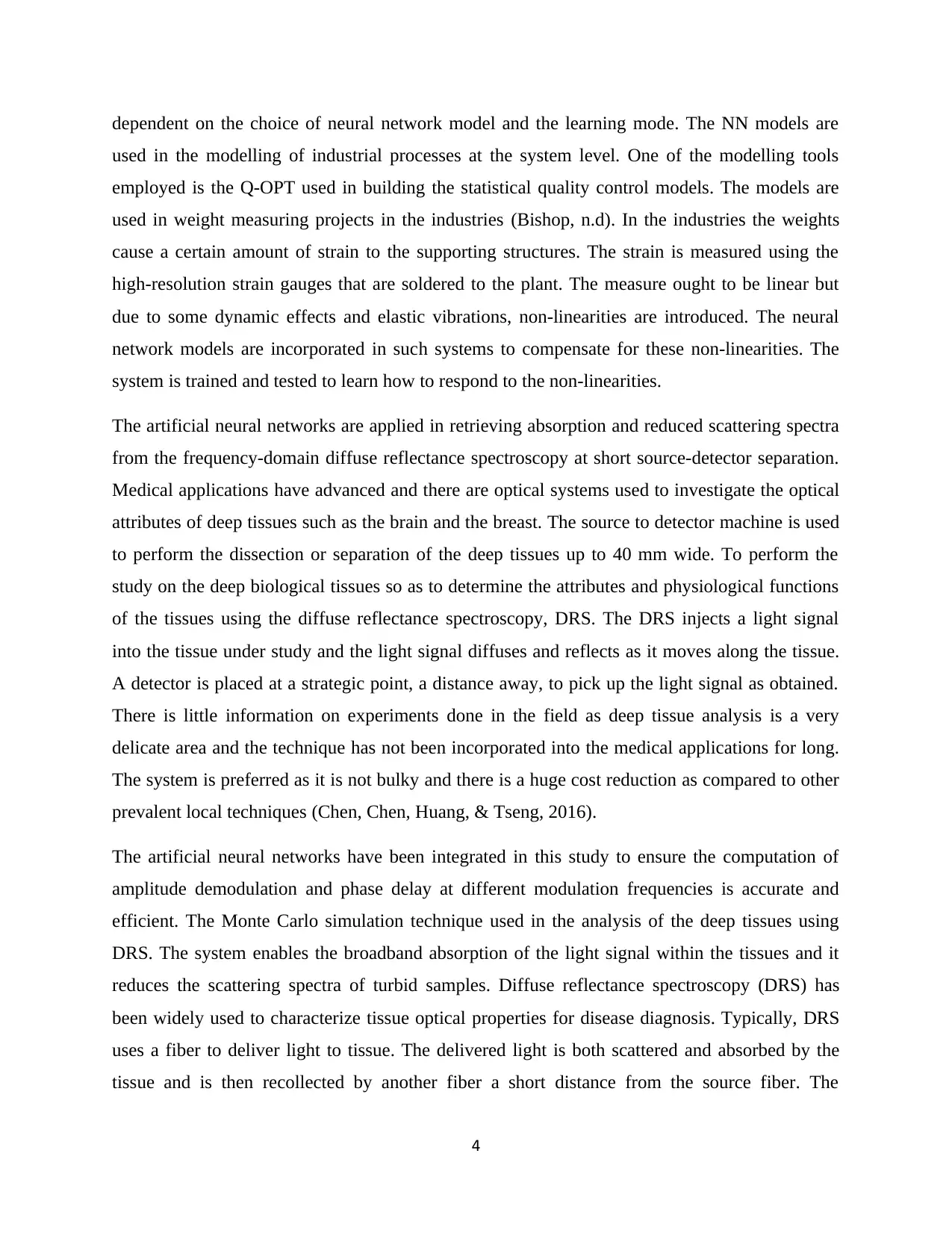
dependent on the choice of neural network model and the learning mode. The NN models are
used in the modelling of industrial processes at the system level. One of the modelling tools
employed is the Q-OPT used in building the statistical quality control models. The models are
used in weight measuring projects in the industries (Bishop, n.d). In the industries the weights
cause a certain amount of strain to the supporting structures. The strain is measured using the
high-resolution strain gauges that are soldered to the plant. The measure ought to be linear but
due to some dynamic effects and elastic vibrations, non-linearities are introduced. The neural
network models are incorporated in such systems to compensate for these non-linearities. The
system is trained and tested to learn how to respond to the non-linearities.
The artificial neural networks are applied in retrieving absorption and reduced scattering spectra
from the frequency-domain diffuse reflectance spectroscopy at short source-detector separation.
Medical applications have advanced and there are optical systems used to investigate the optical
attributes of deep tissues such as the brain and the breast. The source to detector machine is used
to perform the dissection or separation of the deep tissues up to 40 mm wide. To perform the
study on the deep biological tissues so as to determine the attributes and physiological functions
of the tissues using the diffuse reflectance spectroscopy, DRS. The DRS injects a light signal
into the tissue under study and the light signal diffuses and reflects as it moves along the tissue.
A detector is placed at a strategic point, a distance away, to pick up the light signal as obtained.
There is little information on experiments done in the field as deep tissue analysis is a very
delicate area and the technique has not been incorporated into the medical applications for long.
The system is preferred as it is not bulky and there is a huge cost reduction as compared to other
prevalent local techniques (Chen, Chen, Huang, & Tseng, 2016).
The artificial neural networks have been integrated in this study to ensure the computation of
amplitude demodulation and phase delay at different modulation frequencies is accurate and
efficient. The Monte Carlo simulation technique used in the analysis of the deep tissues using
DRS. The system enables the broadband absorption of the light signal within the tissues and it
reduces the scattering spectra of turbid samples. Diffuse reflectance spectroscopy (DRS) has
been widely used to characterize tissue optical properties for disease diagnosis. Typically, DRS
uses a fiber to deliver light to tissue. The delivered light is both scattered and absorbed by the
tissue and is then recollected by another fiber a short distance from the source fiber. The
4
used in the modelling of industrial processes at the system level. One of the modelling tools
employed is the Q-OPT used in building the statistical quality control models. The models are
used in weight measuring projects in the industries (Bishop, n.d). In the industries the weights
cause a certain amount of strain to the supporting structures. The strain is measured using the
high-resolution strain gauges that are soldered to the plant. The measure ought to be linear but
due to some dynamic effects and elastic vibrations, non-linearities are introduced. The neural
network models are incorporated in such systems to compensate for these non-linearities. The
system is trained and tested to learn how to respond to the non-linearities.
The artificial neural networks are applied in retrieving absorption and reduced scattering spectra
from the frequency-domain diffuse reflectance spectroscopy at short source-detector separation.
Medical applications have advanced and there are optical systems used to investigate the optical
attributes of deep tissues such as the brain and the breast. The source to detector machine is used
to perform the dissection or separation of the deep tissues up to 40 mm wide. To perform the
study on the deep biological tissues so as to determine the attributes and physiological functions
of the tissues using the diffuse reflectance spectroscopy, DRS. The DRS injects a light signal
into the tissue under study and the light signal diffuses and reflects as it moves along the tissue.
A detector is placed at a strategic point, a distance away, to pick up the light signal as obtained.
There is little information on experiments done in the field as deep tissue analysis is a very
delicate area and the technique has not been incorporated into the medical applications for long.
The system is preferred as it is not bulky and there is a huge cost reduction as compared to other
prevalent local techniques (Chen, Chen, Huang, & Tseng, 2016).
The artificial neural networks have been integrated in this study to ensure the computation of
amplitude demodulation and phase delay at different modulation frequencies is accurate and
efficient. The Monte Carlo simulation technique used in the analysis of the deep tissues using
DRS. The system enables the broadband absorption of the light signal within the tissues and it
reduces the scattering spectra of turbid samples. Diffuse reflectance spectroscopy (DRS) has
been widely used to characterize tissue optical properties for disease diagnosis. Typically, DRS
uses a fiber to deliver light to tissue. The delivered light is both scattered and absorbed by the
tissue and is then recollected by another fiber a short distance from the source fiber. The
4
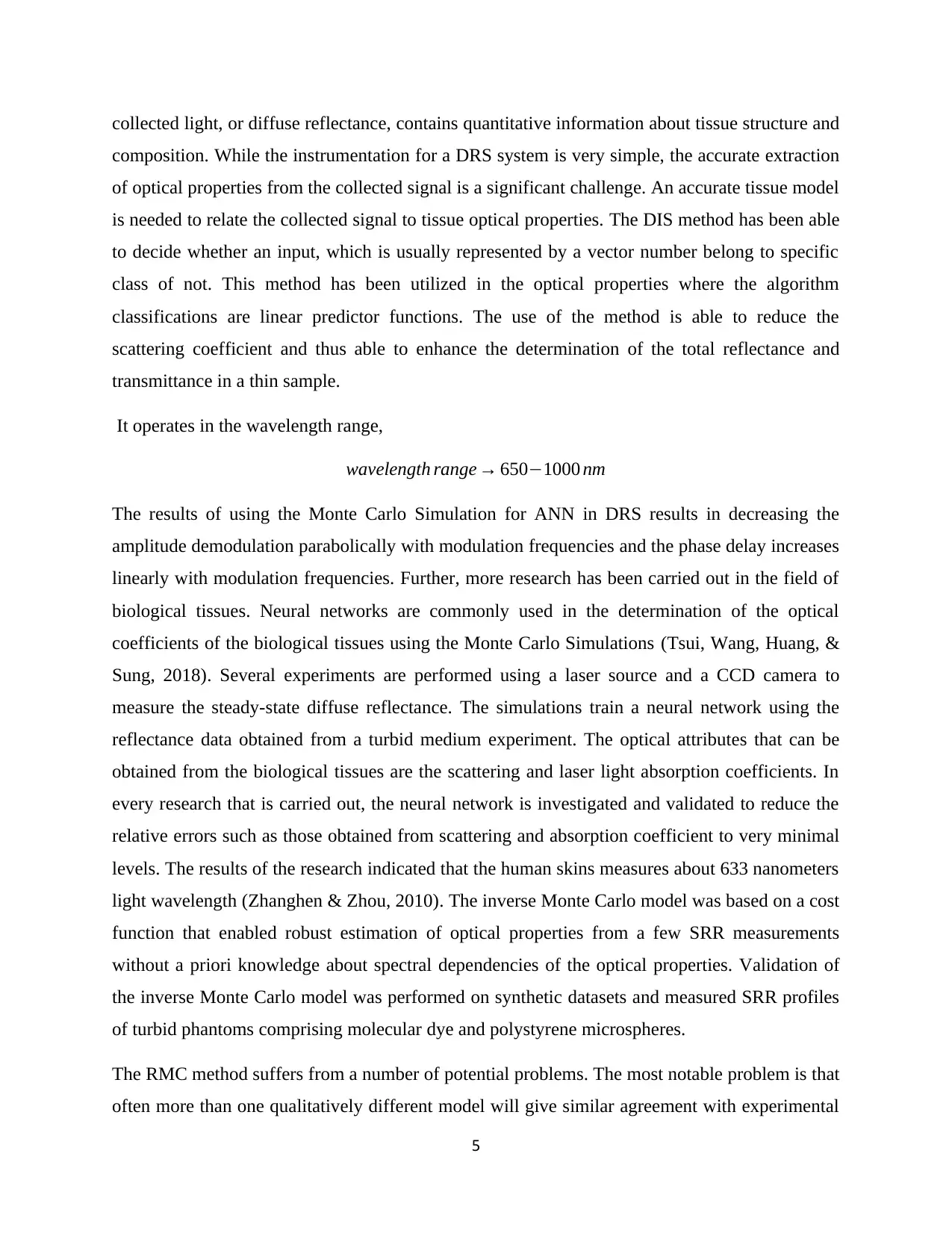
collected light, or diffuse reflectance, contains quantitative information about tissue structure and
composition. While the instrumentation for a DRS system is very simple, the accurate extraction
of optical properties from the collected signal is a significant challenge. An accurate tissue model
is needed to relate the collected signal to tissue optical properties. The DIS method has been able
to decide whether an input, which is usually represented by a vector number belong to specific
class of not. This method has been utilized in the optical properties where the algorithm
classifications are linear predictor functions. The use of the method is able to reduce the
scattering coefficient and thus able to enhance the determination of the total reflectance and
transmittance in a thin sample.
It operates in the wavelength range,
wavelength range → 650−1000 nm
The results of using the Monte Carlo Simulation for ANN in DRS results in decreasing the
amplitude demodulation parabolically with modulation frequencies and the phase delay increases
linearly with modulation frequencies. Further, more research has been carried out in the field of
biological tissues. Neural networks are commonly used in the determination of the optical
coefficients of the biological tissues using the Monte Carlo Simulations (Tsui, Wang, Huang, &
Sung, 2018). Several experiments are performed using a laser source and a CCD camera to
measure the steady-state diffuse reflectance. The simulations train a neural network using the
reflectance data obtained from a turbid medium experiment. The optical attributes that can be
obtained from the biological tissues are the scattering and laser light absorption coefficients. In
every research that is carried out, the neural network is investigated and validated to reduce the
relative errors such as those obtained from scattering and absorption coefficient to very minimal
levels. The results of the research indicated that the human skins measures about 633 nanometers
light wavelength (Zhanghen & Zhou, 2010). The inverse Monte Carlo model was based on a cost
function that enabled robust estimation of optical properties from a few SRR measurements
without a priori knowledge about spectral dependencies of the optical properties. Validation of
the inverse Monte Carlo model was performed on synthetic datasets and measured SRR profiles
of turbid phantoms comprising molecular dye and polystyrene microspheres.
The RMC method suffers from a number of potential problems. The most notable problem is that
often more than one qualitatively different model will give similar agreement with experimental
5
composition. While the instrumentation for a DRS system is very simple, the accurate extraction
of optical properties from the collected signal is a significant challenge. An accurate tissue model
is needed to relate the collected signal to tissue optical properties. The DIS method has been able
to decide whether an input, which is usually represented by a vector number belong to specific
class of not. This method has been utilized in the optical properties where the algorithm
classifications are linear predictor functions. The use of the method is able to reduce the
scattering coefficient and thus able to enhance the determination of the total reflectance and
transmittance in a thin sample.
It operates in the wavelength range,
wavelength range → 650−1000 nm
The results of using the Monte Carlo Simulation for ANN in DRS results in decreasing the
amplitude demodulation parabolically with modulation frequencies and the phase delay increases
linearly with modulation frequencies. Further, more research has been carried out in the field of
biological tissues. Neural networks are commonly used in the determination of the optical
coefficients of the biological tissues using the Monte Carlo Simulations (Tsui, Wang, Huang, &
Sung, 2018). Several experiments are performed using a laser source and a CCD camera to
measure the steady-state diffuse reflectance. The simulations train a neural network using the
reflectance data obtained from a turbid medium experiment. The optical attributes that can be
obtained from the biological tissues are the scattering and laser light absorption coefficients. In
every research that is carried out, the neural network is investigated and validated to reduce the
relative errors such as those obtained from scattering and absorption coefficient to very minimal
levels. The results of the research indicated that the human skins measures about 633 nanometers
light wavelength (Zhanghen & Zhou, 2010). The inverse Monte Carlo model was based on a cost
function that enabled robust estimation of optical properties from a few SRR measurements
without a priori knowledge about spectral dependencies of the optical properties. Validation of
the inverse Monte Carlo model was performed on synthetic datasets and measured SRR profiles
of turbid phantoms comprising molecular dye and polystyrene microspheres.
The RMC method suffers from a number of potential problems. The most notable problem is that
often more than one qualitatively different model will give similar agreement with experimental
5
⊘ This is a preview!⊘
Do you want full access?
Subscribe today to unlock all pages.

Trusted by 1+ million students worldwide
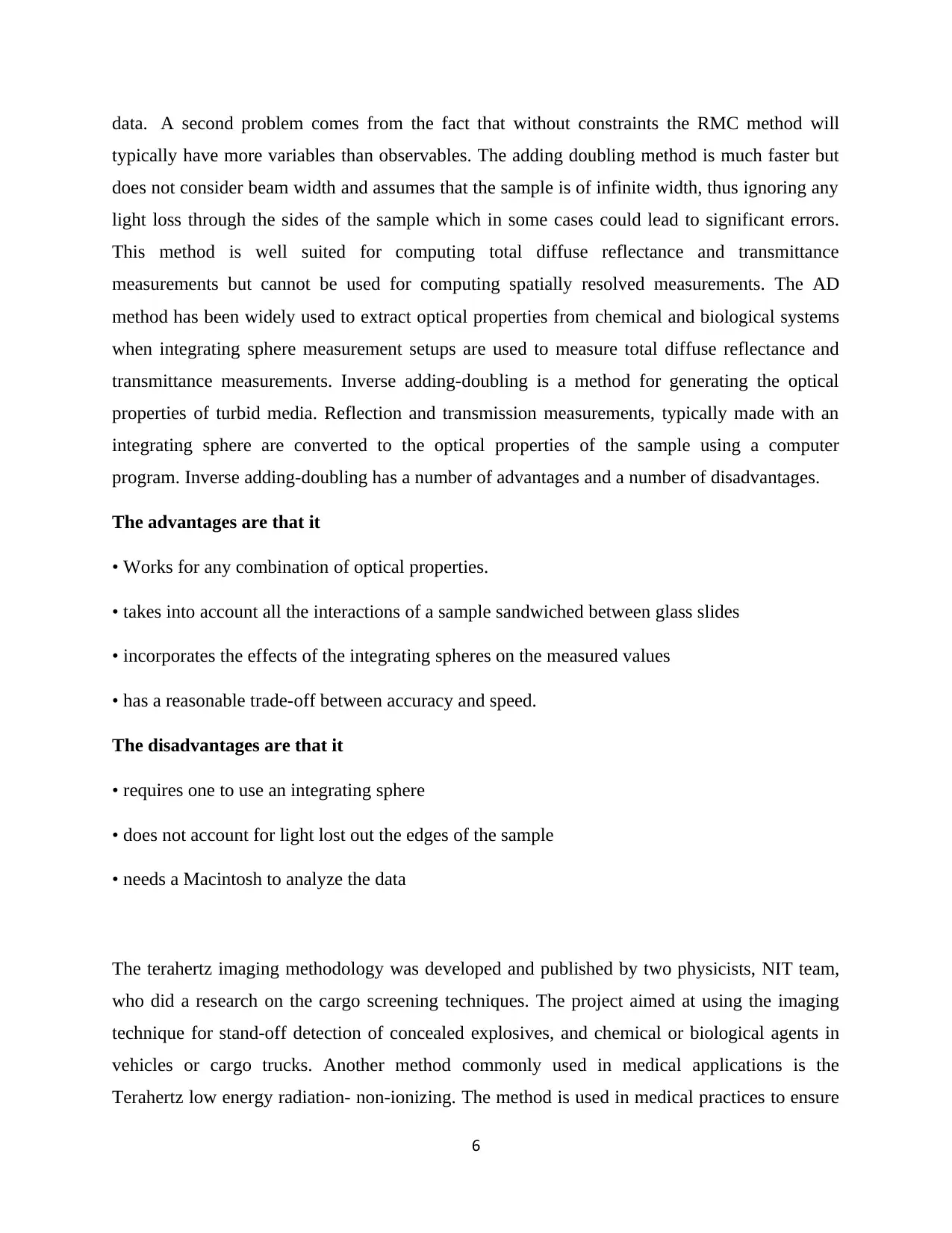
data. A second problem comes from the fact that without constraints the RMC method will
typically have more variables than observables. The adding doubling method is much faster but
does not consider beam width and assumes that the sample is of infinite width, thus ignoring any
light loss through the sides of the sample which in some cases could lead to significant errors.
This method is well suited for computing total diffuse reflectance and transmittance
measurements but cannot be used for computing spatially resolved measurements. The AD
method has been widely used to extract optical properties from chemical and biological systems
when integrating sphere measurement setups are used to measure total diffuse reflectance and
transmittance measurements. Inverse adding-doubling is a method for generating the optical
properties of turbid media. Reflection and transmission measurements, typically made with an
integrating sphere are converted to the optical properties of the sample using a computer
program. Inverse adding-doubling has a number of advantages and a number of disadvantages.
The advantages are that it
• Works for any combination of optical properties.
• takes into account all the interactions of a sample sandwiched between glass slides
• incorporates the effects of the integrating spheres on the measured values
• has a reasonable trade-off between accuracy and speed.
The disadvantages are that it
• requires one to use an integrating sphere
• does not account for light lost out the edges of the sample
• needs a Macintosh to analyze the data
The terahertz imaging methodology was developed and published by two physicists, NIT team,
who did a research on the cargo screening techniques. The project aimed at using the imaging
technique for stand-off detection of concealed explosives, and chemical or biological agents in
vehicles or cargo trucks. Another method commonly used in medical applications is the
Terahertz low energy radiation- non-ionizing. The method is used in medical practices to ensure
6
typically have more variables than observables. The adding doubling method is much faster but
does not consider beam width and assumes that the sample is of infinite width, thus ignoring any
light loss through the sides of the sample which in some cases could lead to significant errors.
This method is well suited for computing total diffuse reflectance and transmittance
measurements but cannot be used for computing spatially resolved measurements. The AD
method has been widely used to extract optical properties from chemical and biological systems
when integrating sphere measurement setups are used to measure total diffuse reflectance and
transmittance measurements. Inverse adding-doubling is a method for generating the optical
properties of turbid media. Reflection and transmission measurements, typically made with an
integrating sphere are converted to the optical properties of the sample using a computer
program. Inverse adding-doubling has a number of advantages and a number of disadvantages.
The advantages are that it
• Works for any combination of optical properties.
• takes into account all the interactions of a sample sandwiched between glass slides
• incorporates the effects of the integrating spheres on the measured values
• has a reasonable trade-off between accuracy and speed.
The disadvantages are that it
• requires one to use an integrating sphere
• does not account for light lost out the edges of the sample
• needs a Macintosh to analyze the data
The terahertz imaging methodology was developed and published by two physicists, NIT team,
who did a research on the cargo screening techniques. The project aimed at using the imaging
technique for stand-off detection of concealed explosives, and chemical or biological agents in
vehicles or cargo trucks. Another method commonly used in medical applications is the
Terahertz low energy radiation- non-ionizing. The method is used in medical practices to ensure
6
Paraphrase This Document
Need a fresh take? Get an instant paraphrase of this document with our AI Paraphraser
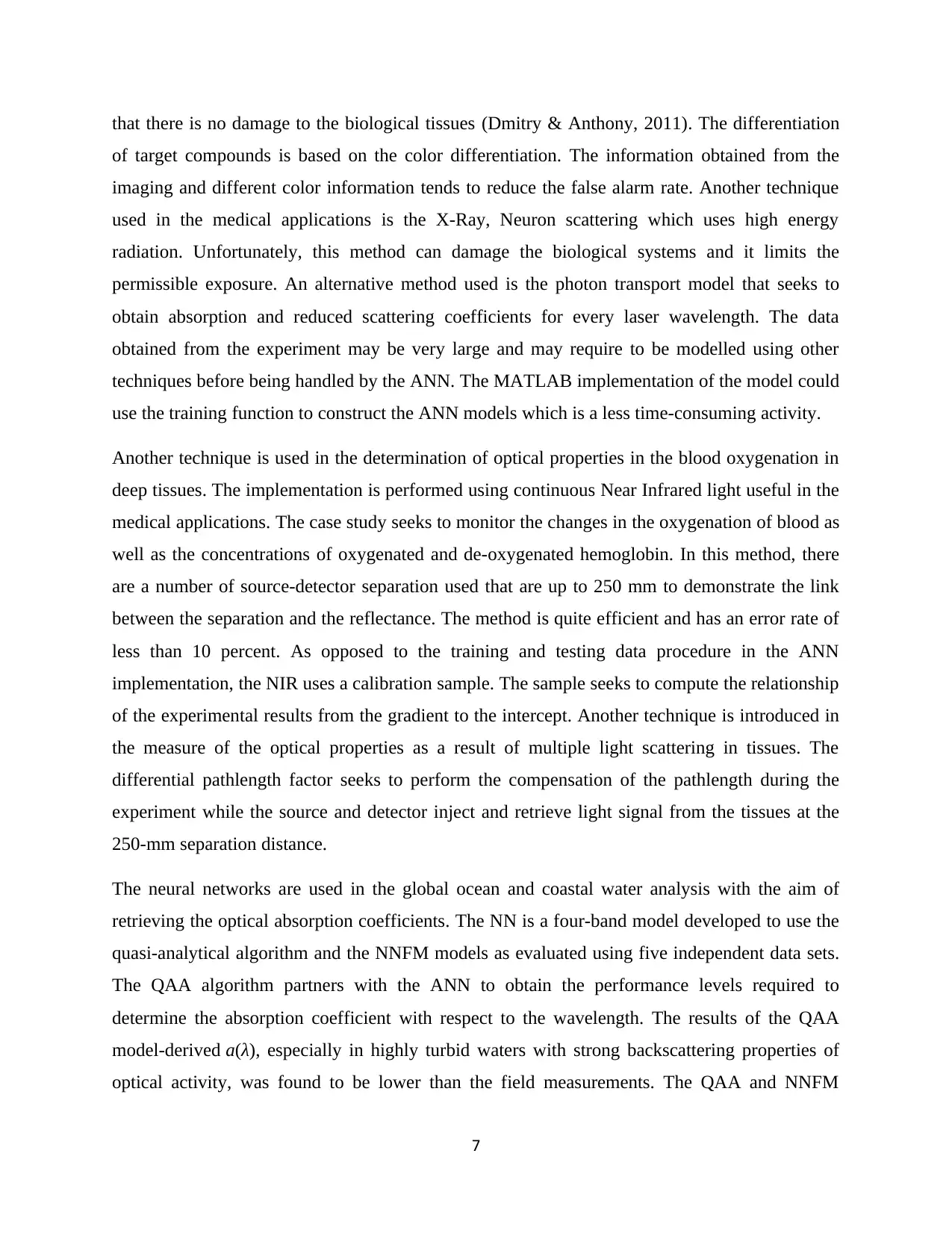
that there is no damage to the biological tissues (Dmitry & Anthony, 2011). The differentiation
of target compounds is based on the color differentiation. The information obtained from the
imaging and different color information tends to reduce the false alarm rate. Another technique
used in the medical applications is the X-Ray, Neuron scattering which uses high energy
radiation. Unfortunately, this method can damage the biological systems and it limits the
permissible exposure. An alternative method used is the photon transport model that seeks to
obtain absorption and reduced scattering coefficients for every laser wavelength. The data
obtained from the experiment may be very large and may require to be modelled using other
techniques before being handled by the ANN. The MATLAB implementation of the model could
use the training function to construct the ANN models which is a less time-consuming activity.
Another technique is used in the determination of optical properties in the blood oxygenation in
deep tissues. The implementation is performed using continuous Near Infrared light useful in the
medical applications. The case study seeks to monitor the changes in the oxygenation of blood as
well as the concentrations of oxygenated and de-oxygenated hemoglobin. In this method, there
are a number of source-detector separation used that are up to 250 mm to demonstrate the link
between the separation and the reflectance. The method is quite efficient and has an error rate of
less than 10 percent. As opposed to the training and testing data procedure in the ANN
implementation, the NIR uses a calibration sample. The sample seeks to compute the relationship
of the experimental results from the gradient to the intercept. Another technique is introduced in
the measure of the optical properties as a result of multiple light scattering in tissues. The
differential pathlength factor seeks to perform the compensation of the pathlength during the
experiment while the source and detector inject and retrieve light signal from the tissues at the
250-mm separation distance.
The neural networks are used in the global ocean and coastal water analysis with the aim of
retrieving the optical absorption coefficients. The NN is a four-band model developed to use the
quasi-analytical algorithm and the NNFM models as evaluated using five independent data sets.
The QAA algorithm partners with the ANN to obtain the performance levels required to
determine the absorption coefficient with respect to the wavelength. The results of the QAA
model‐derived a(λ), especially in highly turbid waters with strong backscattering properties of
optical activity, was found to be lower than the field measurements. The QAA and NNFM
7
of target compounds is based on the color differentiation. The information obtained from the
imaging and different color information tends to reduce the false alarm rate. Another technique
used in the medical applications is the X-Ray, Neuron scattering which uses high energy
radiation. Unfortunately, this method can damage the biological systems and it limits the
permissible exposure. An alternative method used is the photon transport model that seeks to
obtain absorption and reduced scattering coefficients for every laser wavelength. The data
obtained from the experiment may be very large and may require to be modelled using other
techniques before being handled by the ANN. The MATLAB implementation of the model could
use the training function to construct the ANN models which is a less time-consuming activity.
Another technique is used in the determination of optical properties in the blood oxygenation in
deep tissues. The implementation is performed using continuous Near Infrared light useful in the
medical applications. The case study seeks to monitor the changes in the oxygenation of blood as
well as the concentrations of oxygenated and de-oxygenated hemoglobin. In this method, there
are a number of source-detector separation used that are up to 250 mm to demonstrate the link
between the separation and the reflectance. The method is quite efficient and has an error rate of
less than 10 percent. As opposed to the training and testing data procedure in the ANN
implementation, the NIR uses a calibration sample. The sample seeks to compute the relationship
of the experimental results from the gradient to the intercept. Another technique is introduced in
the measure of the optical properties as a result of multiple light scattering in tissues. The
differential pathlength factor seeks to perform the compensation of the pathlength during the
experiment while the source and detector inject and retrieve light signal from the tissues at the
250-mm separation distance.
The neural networks are used in the global ocean and coastal water analysis with the aim of
retrieving the optical absorption coefficients. The NN is a four-band model developed to use the
quasi-analytical algorithm and the NNFM models as evaluated using five independent data sets.
The QAA algorithm partners with the ANN to obtain the performance levels required to
determine the absorption coefficient with respect to the wavelength. The results of the QAA
model‐derived a(λ), especially in highly turbid waters with strong backscattering properties of
optical activity, was found to be lower than the field measurements. The QAA and NNFM
7
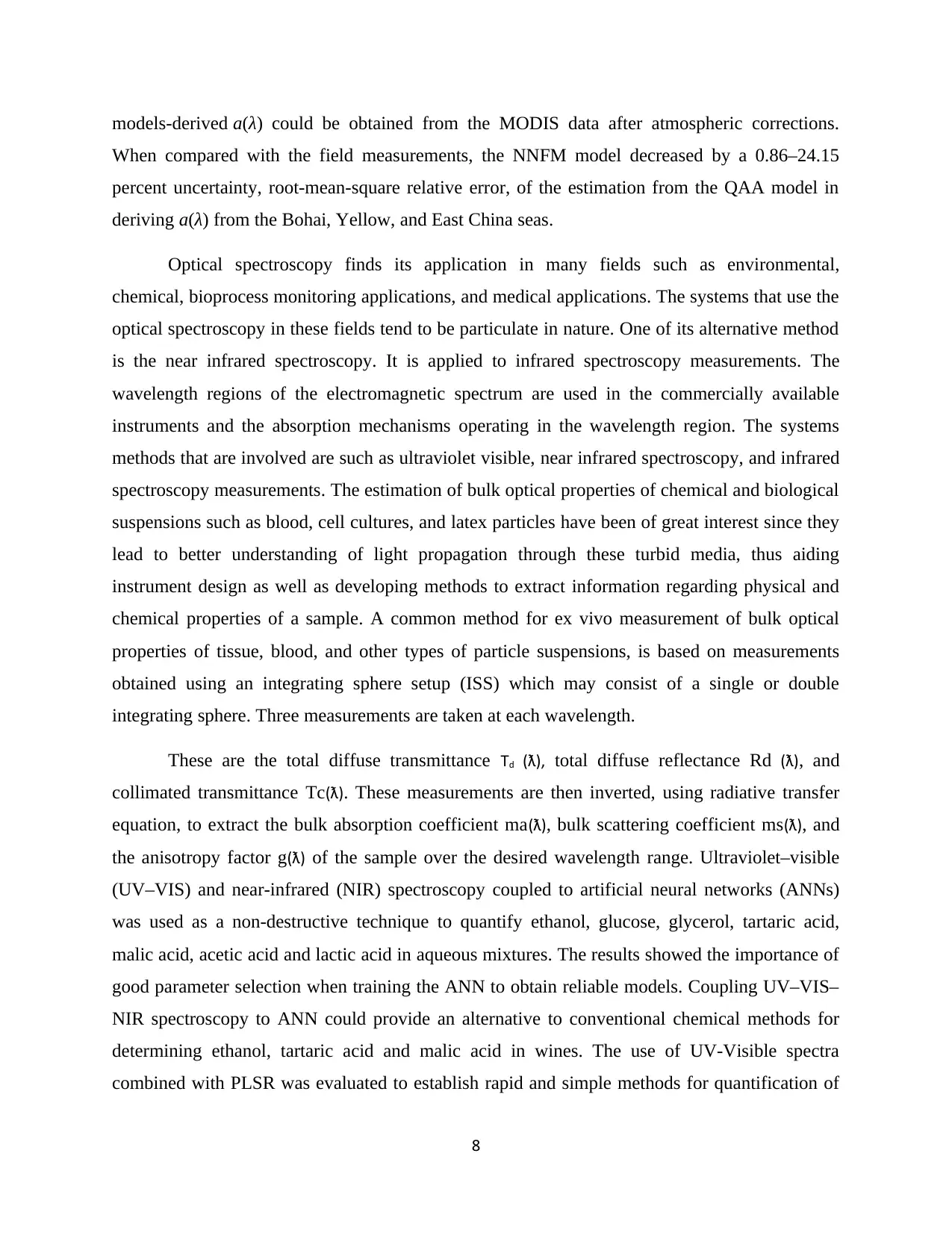
models‐derived a(λ) could be obtained from the MODIS data after atmospheric corrections.
When compared with the field measurements, the NNFM model decreased by a 0.86–24.15
percent uncertainty, root‐mean‐square relative error, of the estimation from the QAA model in
deriving a(λ) from the Bohai, Yellow, and East China seas.
Optical spectroscopy finds its application in many fields such as environmental,
chemical, bioprocess monitoring applications, and medical applications. The systems that use the
optical spectroscopy in these fields tend to be particulate in nature. One of its alternative method
is the near infrared spectroscopy. It is applied to infrared spectroscopy measurements. The
wavelength regions of the electromagnetic spectrum are used in the commercially available
instruments and the absorption mechanisms operating in the wavelength region. The systems
methods that are involved are such as ultraviolet visible, near infrared spectroscopy, and infrared
spectroscopy measurements. The estimation of bulk optical properties of chemical and biological
suspensions such as blood, cell cultures, and latex particles have been of great interest since they
lead to better understanding of light propagation through these turbid media, thus aiding
instrument design as well as developing methods to extract information regarding physical and
chemical properties of a sample. A common method for ex vivo measurement of bulk optical
properties of tissue, blood, and other types of particle suspensions, is based on measurements
obtained using an integrating sphere setup (ISS) which may consist of a single or double
integrating sphere. Three measurements are taken at each wavelength.
These are the total diffuse transmittance Td (ƛ), total diffuse reflectance Rd (ƛ), and
collimated transmittance Tc(ƛ). These measurements are then inverted, using radiative transfer
equation, to extract the bulk absorption coefficient ma(ƛ), bulk scattering coefficient ms(ƛ), and
the anisotropy factor g(ƛ) of the sample over the desired wavelength range. Ultraviolet–visible
(UV–VIS) and near-infrared (NIR) spectroscopy coupled to artificial neural networks (ANNs)
was used as a non-destructive technique to quantify ethanol, glucose, glycerol, tartaric acid,
malic acid, acetic acid and lactic acid in aqueous mixtures. The results showed the importance of
good parameter selection when training the ANN to obtain reliable models. Coupling UV–VIS–
NIR spectroscopy to ANN could provide an alternative to conventional chemical methods for
determining ethanol, tartaric acid and malic acid in wines. The use of UV-Visible spectra
combined with PLSR was evaluated to establish rapid and simple methods for quantification of
8
When compared with the field measurements, the NNFM model decreased by a 0.86–24.15
percent uncertainty, root‐mean‐square relative error, of the estimation from the QAA model in
deriving a(λ) from the Bohai, Yellow, and East China seas.
Optical spectroscopy finds its application in many fields such as environmental,
chemical, bioprocess monitoring applications, and medical applications. The systems that use the
optical spectroscopy in these fields tend to be particulate in nature. One of its alternative method
is the near infrared spectroscopy. It is applied to infrared spectroscopy measurements. The
wavelength regions of the electromagnetic spectrum are used in the commercially available
instruments and the absorption mechanisms operating in the wavelength region. The systems
methods that are involved are such as ultraviolet visible, near infrared spectroscopy, and infrared
spectroscopy measurements. The estimation of bulk optical properties of chemical and biological
suspensions such as blood, cell cultures, and latex particles have been of great interest since they
lead to better understanding of light propagation through these turbid media, thus aiding
instrument design as well as developing methods to extract information regarding physical and
chemical properties of a sample. A common method for ex vivo measurement of bulk optical
properties of tissue, blood, and other types of particle suspensions, is based on measurements
obtained using an integrating sphere setup (ISS) which may consist of a single or double
integrating sphere. Three measurements are taken at each wavelength.
These are the total diffuse transmittance Td (ƛ), total diffuse reflectance Rd (ƛ), and
collimated transmittance Tc(ƛ). These measurements are then inverted, using radiative transfer
equation, to extract the bulk absorption coefficient ma(ƛ), bulk scattering coefficient ms(ƛ), and
the anisotropy factor g(ƛ) of the sample over the desired wavelength range. Ultraviolet–visible
(UV–VIS) and near-infrared (NIR) spectroscopy coupled to artificial neural networks (ANNs)
was used as a non-destructive technique to quantify ethanol, glucose, glycerol, tartaric acid,
malic acid, acetic acid and lactic acid in aqueous mixtures. The results showed the importance of
good parameter selection when training the ANN to obtain reliable models. Coupling UV–VIS–
NIR spectroscopy to ANN could provide an alternative to conventional chemical methods for
determining ethanol, tartaric acid and malic acid in wines. The use of UV-Visible spectra
combined with PLSR was evaluated to establish rapid and simple methods for quantification of
8
⊘ This is a preview!⊘
Do you want full access?
Subscribe today to unlock all pages.

Trusted by 1+ million students worldwide

adulteration in leak-arabica coffee blend. Several preprocessing methods were tested and the
results show that most of the preprocessing spectra were effective in improving the quality of
calibration models with the best PLS calibration model selected.
9
results show that most of the preprocessing spectra were effective in improving the quality of
calibration models with the best PLS calibration model selected.
9
Paraphrase This Document
Need a fresh take? Get an instant paraphrase of this document with our AI Paraphraser
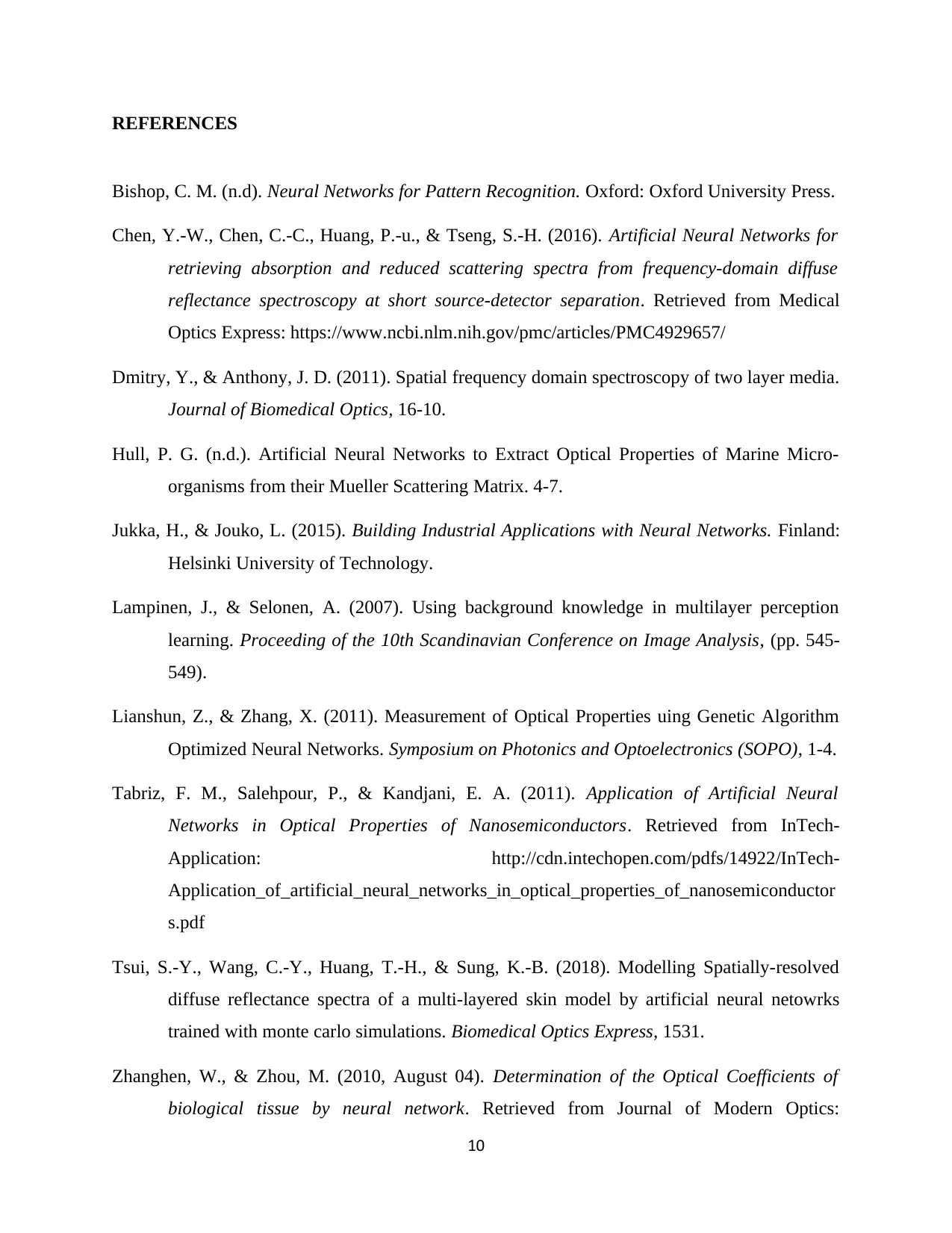
REFERENCES
Bishop, C. M. (n.d). Neural Networks for Pattern Recognition. Oxford: Oxford University Press.
Chen, Y.-W., Chen, C.-C., Huang, P.-u., & Tseng, S.-H. (2016). Artificial Neural Networks for
retrieving absorption and reduced scattering spectra from frequency-domain diffuse
reflectance spectroscopy at short source-detector separation. Retrieved from Medical
Optics Express: https://www.ncbi.nlm.nih.gov/pmc/articles/PMC4929657/
Dmitry, Y., & Anthony, J. D. (2011). Spatial frequency domain spectroscopy of two layer media.
Journal of Biomedical Optics, 16-10.
Hull, P. G. (n.d.). Artificial Neural Networks to Extract Optical Properties of Marine Micro-
organisms from their Mueller Scattering Matrix. 4-7.
Jukka, H., & Jouko, L. (2015). Building Industrial Applications with Neural Networks. Finland:
Helsinki University of Technology.
Lampinen, J., & Selonen, A. (2007). Using background knowledge in multilayer perception
learning. Proceeding of the 10th Scandinavian Conference on Image Analysis, (pp. 545-
549).
Lianshun, Z., & Zhang, X. (2011). Measurement of Optical Properties uing Genetic Algorithm
Optimized Neural Networks. Symposium on Photonics and Optoelectronics (SOPO), 1-4.
Tabriz, F. M., Salehpour, P., & Kandjani, E. A. (2011). Application of Artificial Neural
Networks in Optical Properties of Nanosemiconductors. Retrieved from InTech-
Application: http://cdn.intechopen.com/pdfs/14922/InTech-
Application_of_artificial_neural_networks_in_optical_properties_of_nanosemiconductor
s.pdf
Tsui, S.-Y., Wang, C.-Y., Huang, T.-H., & Sung, K.-B. (2018). Modelling Spatially-resolved
diffuse reflectance spectra of a multi-layered skin model by artificial neural netowrks
trained with monte carlo simulations. Biomedical Optics Express, 1531.
Zhanghen, W., & Zhou, M. (2010, August 04). Determination of the Optical Coefficients of
biological tissue by neural network. Retrieved from Journal of Modern Optics:
10
Bishop, C. M. (n.d). Neural Networks for Pattern Recognition. Oxford: Oxford University Press.
Chen, Y.-W., Chen, C.-C., Huang, P.-u., & Tseng, S.-H. (2016). Artificial Neural Networks for
retrieving absorption and reduced scattering spectra from frequency-domain diffuse
reflectance spectroscopy at short source-detector separation. Retrieved from Medical
Optics Express: https://www.ncbi.nlm.nih.gov/pmc/articles/PMC4929657/
Dmitry, Y., & Anthony, J. D. (2011). Spatial frequency domain spectroscopy of two layer media.
Journal of Biomedical Optics, 16-10.
Hull, P. G. (n.d.). Artificial Neural Networks to Extract Optical Properties of Marine Micro-
organisms from their Mueller Scattering Matrix. 4-7.
Jukka, H., & Jouko, L. (2015). Building Industrial Applications with Neural Networks. Finland:
Helsinki University of Technology.
Lampinen, J., & Selonen, A. (2007). Using background knowledge in multilayer perception
learning. Proceeding of the 10th Scandinavian Conference on Image Analysis, (pp. 545-
549).
Lianshun, Z., & Zhang, X. (2011). Measurement of Optical Properties uing Genetic Algorithm
Optimized Neural Networks. Symposium on Photonics and Optoelectronics (SOPO), 1-4.
Tabriz, F. M., Salehpour, P., & Kandjani, E. A. (2011). Application of Artificial Neural
Networks in Optical Properties of Nanosemiconductors. Retrieved from InTech-
Application: http://cdn.intechopen.com/pdfs/14922/InTech-
Application_of_artificial_neural_networks_in_optical_properties_of_nanosemiconductor
s.pdf
Tsui, S.-Y., Wang, C.-Y., Huang, T.-H., & Sung, K.-B. (2018). Modelling Spatially-resolved
diffuse reflectance spectra of a multi-layered skin model by artificial neural netowrks
trained with monte carlo simulations. Biomedical Optics Express, 1531.
Zhanghen, W., & Zhou, M. (2010, August 04). Determination of the Optical Coefficients of
biological tissue by neural network. Retrieved from Journal of Modern Optics:
10

https://www.tandfonline.com/doi/full/10.1080/09500340.2010.500106?
scroll=top&needAccess=true
11
scroll=top&needAccess=true
11
⊘ This is a preview!⊘
Do you want full access?
Subscribe today to unlock all pages.

Trusted by 1+ million students worldwide
1 out of 12
Your All-in-One AI-Powered Toolkit for Academic Success.
+13062052269
info@desklib.com
Available 24*7 on WhatsApp / Email
![[object Object]](/_next/static/media/star-bottom.7253800d.svg)
Unlock your academic potential
Copyright © 2020–2025 A2Z Services. All Rights Reserved. Developed and managed by ZUCOL.
